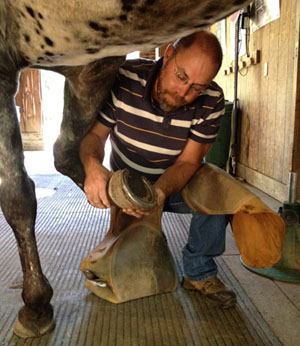10 tips to help your farrier help you
Ten Ways to Retain Your Farrier... Helpful Advice from a Veteran Horse Shoer.
by Bernadette Palmeri with photographs & models courtesy of Rivendell Riding Academy
As tough as it may be to find a farrier who is compatible with your horse’s shoeing needs, it can be equally difficult to know what your farrier needs from you and your horse. In search of some answers, I interviewed a veteran of the industry, certified farrier Michael Lancto.
Michael Lancto grew up riding and competing in Pony Club and 4H in upstate New York. He has been shoeing horses for the past 33 years in Duchess County and around the world in Germany, Holland, and Puerto Rico. Michael first began his career as a farrier by apprenticing with the Pavelek brothers at age 17. Today, Michael shoes horses throughout Duchess County and has taken on multiple apprentices with which to share his knowledge and experience. Here are his top ten tips to helping your farrier help you:
1. Prepare a clean, dry, well-lit area
It is important to make sure your farrier has a safe and quiet place to work. This includes access to an electrical outlet that can provide enough electricity to run modern power tools and will support your farrier’s equipment.
2. Have the horses in and their hooves dry
Picking your horses feet and keeping them in a stall a few hours before they get new shoes is a good way to ensure that their feet will be dry and ready for your farrier. Most importantly, checking their hooves will give you a chance to look at their shoes and bring up any questions or concerns you may have.
3. Have a payment plan worked out ahead of time
Make sure that you have discussed with all parties involved how and when you are going to pay for the services your farrier is planning to perform. This will avoid any misunderstanding between your farrier and clients.
4. Make sure your horses are well-behaved or hire a professional handler
If your horse does not like standing for your farrier, be sure to arrange ahead of time who will be responsible for tending to your horse as he gets his new shoes. Michael suggests a professional handler over simply drugging your horse (unless he is unsafe) so that your horse will eventually learn to stand and relax during the experience.
5. Keep pasture/turnout well drained
While we cannot control the weather, we can control how we protect our horses from it. If your horse has poor quality hoof walls, keep him in on wet days. Many farms have a smaller, “wet paddock” that is particularly dry and useful for horses who cannot be in a stall. Using such a space will not only help your horse’s hooves stay intact, but will also save the footing in your other paddocks that do not drain well.
6. Avoid using hoof products and/or supplements as a quick fix
While these items can be helpful, it is tough to hold products completely responsible for healthy hooves. The best and cheapest care is frequent hoof picking and to invest in a good stiff brush for the front of your horse’s hooves.
7. Curry and vacuum over bathing
This is one of the most useful tips for keeping your horse’s hooves healthy. Instead of reaching for the hose, pick up a curry comb (or vacuum) to groom your horse. Keeping hooves dry and clean will protect the hoof walls and avoid common diseases like thrush.
8. Ride your older or especially stiff horses before their appointments
If you have an older horse or one who is naturally stiff before he his exercised, try to ride him before he meets with the farrier. Once your horse is loosened up and can stand more comfortably, he will be a great deal easier to shoe. If you are unable to ride, perhaps a gram of bute or some extra turnout could do the trick.
9. Keep you farrier informed about your plans for the next 6 weeks
It is important to let your farrier know your plans between shoeing dates. If your farrier is in the loop then he/she can make the necessary adjustments to your horse’s shoeing regiment.
10. Keep your horse on a shoeing schedule
Lastly, it is crucial to keep your horse on a shoeing schedule that works for both you and your farrier. By maintaining a regular schedule, you will always know when your horse is due for shoes and your farrier will expect to be at your barn during the week of your appointment.
About the Author: Bernadette Palmeri is a recent graduate of Connecticut College and currently enjoys Eventing with her horses throughout the Northeast.




